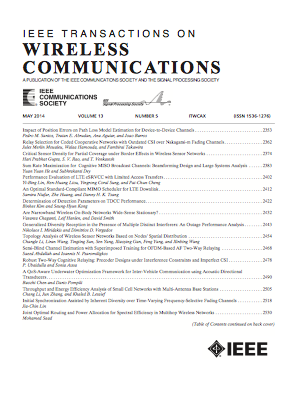广义码频空间索引调制:下一代绿色通信解决方案
IF 10.7
1区 计算机科学
Q1 ENGINEERING, ELECTRICAL & ELECTRONIC
引用次数: 0
摘要
针对下一代绿色通信系统,本文提出了一种基于分频阵列多输入多输出(FDA-MIMO)技术的创新通信系统,其目标是在保持低功耗的同时实现高数据速率。该系统采用频偏折射率调制、多天线空间折射率调制和扩频码折射率调制技术。在本文提出的广义码索引调制辅助频偏重调多天线空间调制(GCIM-FORMASM)系统中,将来位分为5个部分:激活多个发射天线的空间调制位、FDA天线的频偏索引位(包括频偏组合位和频偏重调位)、扩频码索引调制位和调制符号位。随后,本文利用FDA发射的正交波形设计相应的发射和接收结构,并给出接收信号的具体表达式。同时,为了降低最大似然(ML)算法的解码复杂度,我们提出了一种利用扩展码的正交性的基于三阶段解扩的低复杂度(DBLC)算法。此外,还推导了DBLC算法平均误码率(ABEP)上界的封闭表达式。分析能源效率和数据传输速率等指标表明,该系统具有低功耗和高数据传输速率的特点,更符合未来绿色通信的概念。综合数值结果验证了所提方法的有效性。本文章由计算机程序翻译,如有差异,请以英文原文为准。
Generalized Code-Frequency-Space Index Modulation: A Next-Generation Green Communication Solution
For next-generation green communication systems, this article proposes an innovative communication system based on frequency-diverse array-multiple-input multiple-output (FDA-MIMO) technology, which aims to achieve high data rates while maintaining low power consumption. This system utilizes frequency offset index realign modulation, multiple-antenna spatial index modulation, and spreading code index modulation techniques. In the proposed generalized code index modulation-aided frequency offset realign multiple-antenna spatial modulation (GCIM-FORMASM) system, the coming bits are divided into five parts: spatial modulation bits by activating multiple transmit antennas, frequency offset index bits of the FDA antennas, including frequency offset combination bits and frequency offset realign bits, spreading code index modulation bits, and modulated symbol bits. Subsequently, this paper utilizes the orthogonal waveforms transmitted by the FDA to design the corresponding transmitter and receiver structures and provide specific expressions for the received signals. Meanwhile, to reduce the decoding complexity of the maximum likelihood (ML) algorithm, we propose a three-stage despreading-based low complexity (DBLC) algorithm leveraging the orthogonality of the spreading codes. Additionally, a closed-form expression for the upper bound of the average bit error probability (ABEP) of the DBLC algorithm has been derived. Analyzing metrics such as energy efficiency and data rate shows that the proposed system features low power consumption and high data transmission rates, which aligns better with the concept of future green communications. The effectiveness of our proposed methods has been validated through comprehensive numerical results.
求助全文
通过发布文献求助,成功后即可免费获取论文全文。
去求助
来源期刊
CiteScore
18.60
自引率
10.60%
发文量
708
审稿时长
5.6 months
期刊介绍:
The IEEE Transactions on Wireless Communications is a prestigious publication that showcases cutting-edge advancements in wireless communications. It welcomes both theoretical and practical contributions in various areas. The scope of the Transactions encompasses a wide range of topics, including modulation and coding, detection and estimation, propagation and channel characterization, and diversity techniques. The journal also emphasizes the physical and link layer communication aspects of network architectures and protocols.
The journal is open to papers on specific topics or non-traditional topics related to specific application areas. This includes simulation tools and methodologies, orthogonal frequency division multiplexing, MIMO systems, and wireless over optical technologies.
Overall, the IEEE Transactions on Wireless Communications serves as a platform for high-quality manuscripts that push the boundaries of wireless communications and contribute to advancements in the field.

 求助内容:
求助内容: 应助结果提醒方式:
应助结果提醒方式:


